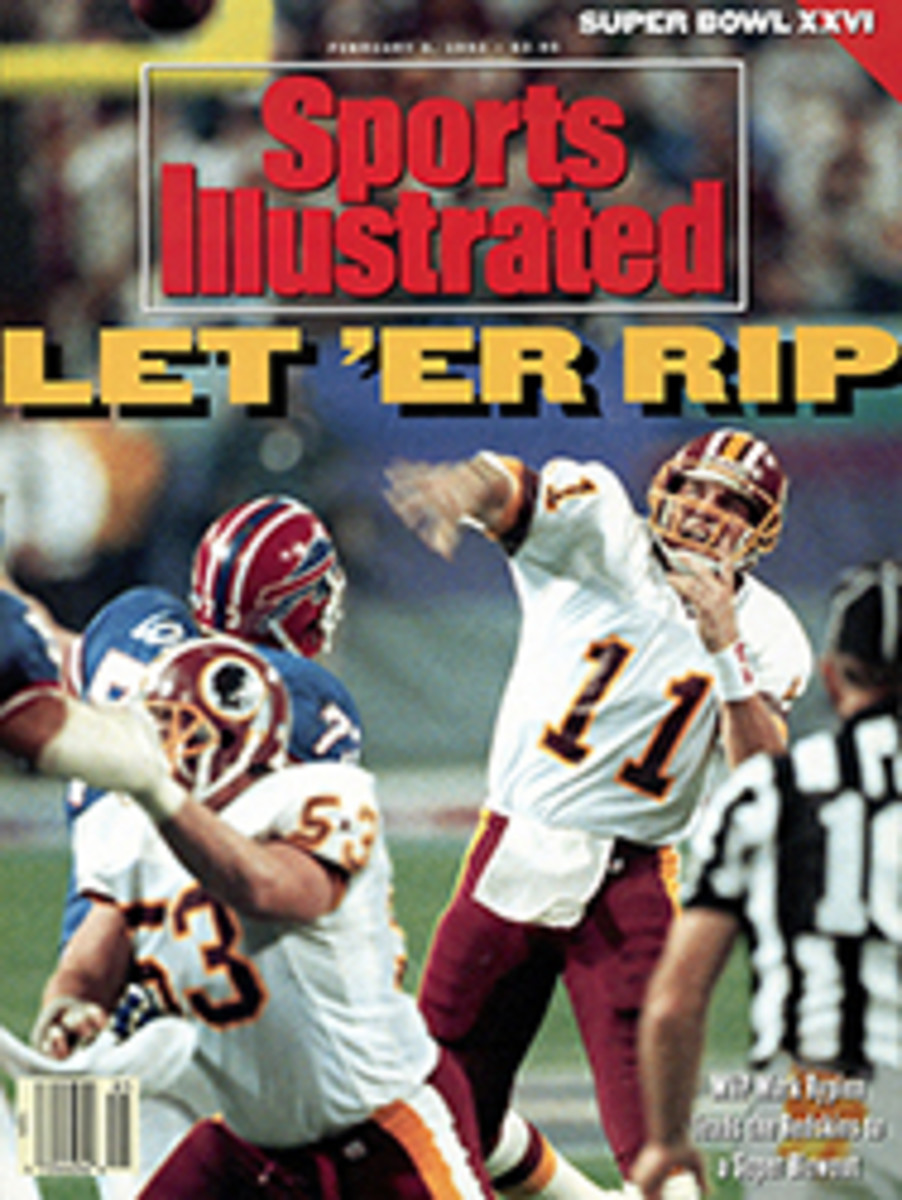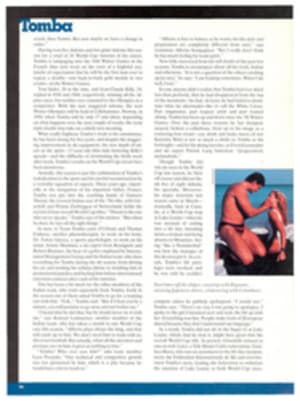
Two Australian Opens
There were two australian opens this year: the McEnroe Open, which ended on the second Wednesday of the two-week competition when a rapturous crowd at Melbourne's National Tennis Centre rose to bid farewell to 32-year-old John McEnroe following his quarterfinal defeat; and the Anticlimax Open, which ended with Monica Seles, the heavy favorite, coasting to the women's title and Mr. Anonymous winning the men's championship.
Who was that man under the white cap who had risen from 25th to second in the world in the past 12 months? Last year Jim Courier won the French Open on clay and reached the final of the U.S. Open on hard court. But he was routed in the title match at Flushing Meadow by Stefan Edberg, his final-round opponent in the Australian Open, which also is played on a hard surface, albeit a slower one. Thus, wouldn't Edberg, the world's No. 1 and the man with the impenetrable serve-and-volley game, walk all over Courier again? That's what John Newcombe, the great Australian champion, had predicted would happen in his newspaper column on the morning of Sunday's final.
So what happens? Courier wins going away, 6-3, 3-6, 6-4, 6-2. Afterward Tony Pickard, Edberg's coach, said he had never seen his charge play worse. "It was one of those days." said Edberg.
But he didn't lie down and die. Courier shot him dead. From the start Courier made it clear that any ball landing in midcourt would be drilled for a winner. By the final two sets, he was even having his way with Edberg's formidable serve, lacing return after return at Edberg's feet or cleanly past him.
Courier had been scheduled to play his opening match in obscurity on Court 6, until a last-minute scheduling change moved him onto one of the show courts. Hidden under that white cap, he moved methodically through the draw, conceding only one set en route to the semifinals—which brings us to another high point of the Anticlimax Open. Courier didn't even have to play his semi, because his opponent, Richard Krajicek, a promising 20-year-old Dutchman who had defeated Wimbledon champion Michael Stich in the quarterfinals, had to withdraw with a shoulder injury.
Suddenly Courier, the man whom the press had described as anonymous throughout the fortnight, was in the final. And much to the media's surprise, after winning the title, he gave reporters something to write about. Three days earlier, he said, he and his coach, Brad Stine, were jogging along the Yarra River, which runs next to the National Tennis Centre, when Stine issued a challenge: If Courier won the the tournament, Stine would jump into the Yarra. Courier said that if Stine jumped, he would too. Sure enough, right after the final, they both took the plunge. Clearly neither had read that morning's front-page story reporting that the river was 18 times more polluted than the acceptable level.
After showering and changing, Courier appeared in the interview room. "I've been reading about how anonymous I am," he said. "But believe me, I win my matches and I'm there, and maybe next year you guys will know who I am."
Earlier in the week he had said he had no interest in fame, television commercials or the kind of glitz that surrounds Andre Agassi. However, with this latest victory, maybe the endorsements will start flowing in. "You know, that just might happen," said Courier at Sunday's press conference. He then picked up a can of Deep Springs mineral water off the table, held it before the cameras and, pretending to hawk the stuff, said, "Pure Springs mineral water." Oh, well.
Stine, who coaches Courier in tandem with Jose Higueras, said Courier had found it difficult to handle success after he cracked the Top 10 by winning the Lipton International Players Championship in Miami last March. Two months later, during a third-round loss to Andrei Cherkasov at the Italian Open, Courier cried out, "I'm 21, I'm Number 9 in the world, and I'm so unhappy with my life."
After that match, he and Stine had a long conversation. "He was taking himself a little too seriously," recalled Stine upon returning from his dip in the Yarra. "He's a bit introverted, and it took Jose and me awhile to recognize the stress of dealing with his newfound success. With Jim, what you see is what you get. He can be very intense. But he's comfortable now with being Top 10 and Top 5, and beating someone like Stefan in a tournament like this makes him a genuine contender to be Number One."
Indeed, Courier needs to win only a few matches at his next tournament, the Volvo Tennis/San Francisco, which begins on Monday, to replace Edberg atop the rankings. If he's successful, Courier will become the first American to hold the No. 1 spot since McEnroe lost it in September 1985.
Seles is so solidly No. 1 that she just keeps increasing the distance between herself and the pack. She dropped only one set in Melbourne, and she crushed fourth-seeded Arantxa Sanchez Vicario 6-2, 6-2 in the semifinals and Mary Joe Fernandez, the seventh seed, 6-2, 6-3 in the final. Seles has now won four of the last five Grand Slam championships (she pulled out of Wimbledon with shin splints) and has reached the finals of 19 successive tournaments.
Courier and Seles are the ultimate practitioners of the modern power game—all thrash and no grace. But when Seles met the press after beating Fernandez, she wore a 1920s-style hat and long dress, Stateside, Seles may behave like a Madonna wannabe at times, but Down Under, she dreamed of Suzanne Lenglen, the graceful Frenchwoman who won six Wimbledon titles between 1919 and '25.
McEnroe's dream of winning his first Grand Slam crown since the 1984 U.S. Open ended with a 6-4, 6-4, 6-4 loss to unseeded Wayne Ferreira, a 20-year-old South African, but to that point Mac had enjoyed a remarkable run. In the third round he stunned defending champion Boris Becker in straight sets. Then he beat Emilio Sanchez 7-5, 7-6, 4-6, 2-6, 8-6 in a four-hour, 41-minute classic in which Sanchez had three match points and McEnroe six. In short, the first 10 days of the tournament belonged to McEnroe in much the same way that last year's U.S. Open belonged to Jimmy Connors.
McEnroe seemed to have undergone a conversion since his last visit to Melbourne, in 1990, when he became the first player in the open era to be defaulted from a Grand Slam event for misconduct. This is the 15th, and probably last, year on the circuit for McEnroe, who entered this year's tournament ranked 28th. He wanted to leave the adoring Melbourne crowds, who cheered him on through five rounds, with a memory of his talent, not of his tantrums. When he finally succumbed—to a man 18 places below him on the computer, no less—Mac departed without a murmur, graciously praising his young opponent.
McEnroe went the whole tournament without questioning a call. What's more, before leaving, he appeared at the tournament director's office and thanked him for all he had done. McEnroe had settled his affairs in Australia. If 1992 turns out to be his last year on the circuit, Melbourne was the first stop on a Farewell to the World Tour.
PHOTO
CARYN LEVY
For the once faceless Courier, the Open ended with a plunge into celebrity.
PHOTO
CARYN LEVY
Mac stole the show with both his surprising play and his behavior.
PHOTO
CARYN LEVY
Seles showed Fernandez no mercy during the women's final.

